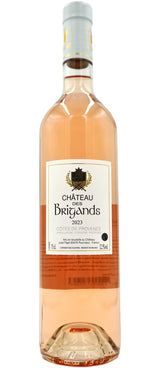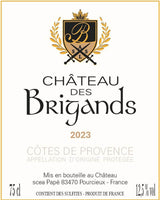Chateau des Brigands
Château des Brigands, Rose, Côtes de Provence 2023
Wine$22
Buy 12+ bottles at $18.70 each and save!
Seductive light pale pink flower color. Complex and attractive scents of stone fruits, ripened yellow peach, minerals (limestone), with notes of raspberry, strawberry, and blackcurrant, topped with a splash of oregano. The minerality is as vibrant as a spring river, bringing well balanced flavors of blackcurrant and peach, followed by a lingering, perfectly integrated sour cherry. Subtle and intense, charming and mesmerizing! Vegan wine. Only sold by CeleriersCellar.com in the USA.
12.50%
30 years old
HVE certified winery. Natural irrigation, no wartering or water retention system. Winter pruning is done by hand, and late in the season (finish in February) to prevent spring frostbite. They apply the “2 bras” cut, with only 5 coursons total. The step includes crushing wine shoot to turn it into additional natural fertilizer. It is followed up by a first mechanical plough to remove shallow roots and add a natural frost protection to the vine. The first trellising of vines is done in April, followed by a mechanical plough back. Along with this task, intensive weeds/grass cutting/grinding are being held until June/July. Only 3 preventive treatments are applied, using organic certified compound. In June, the second trellising takes place to set up for now grownup vines. In September, samples of fruits are tested to define which parcels are being harvested (mechanical). They are non-intensive, and capped at 1 ha per day, to bring only peak maturity to the wines.
ach parcel is brought in and work separately in thermo-regulated stainless-steel tanks, fully destemmed. The cold skin contact macerations (39-41°F) are being held for 3 weeks maximum. Daily Pump over with dry ice brings optimized finesse and delicate aromas. “Stabulation” is the name of this long maceration technique. Alcoholic fermentation, maintained at 60-62°F, takes 4 weeks. It helps express maximum freshness and finesse. Then, a first lees racking is performed, followed by a second one 2-3 weeks after to allow static settling in between. Fermentation are stopped, not allowing malolactic fermentation. Blend of parcels on lees, followed by 2-3 wees settling to do the final racking by filtration by plate. Vegan process.
Grenache 60%, Cinsault 40%
1,000 cases
Provence
With a historically dry and mild winter (barely 50 mm of rain by the end of March), the vines started to grow early. It was a stressful start to the season due to the specter of spring frost. Fortunately, the frost did not happen, and budburst spread evenly through the month of May. At the start of the season, bunches began to form nicely. Spring was cool and rainy. Vegetative growth was perfect. Conditions were ideal. However, mildew pressure was very high, especially in organic farming. It was mandatory to stay alert and keep an eye on the vines to step in at the right time. The resilience of the vines and some meticulous interventions preserved the harvest. With a cool spring, vine growth slowed, and the pace went back to a normal vegetative stage for the season. The welcome rains in May and June (250mm in total) ended abruptly, followed by drastic dry conditions. The hot summer kept the estate healthy, preventing any mildew and other diseases. July and August were very hot, impacting the ripeness of the grapes. In particular, the heatwave from August 15th to 25th, where temperatures rose by two degrees Celsius in one week, disrupted the planification of the harvest. It needed to be early and fast. The stress was worth the effort: this vintage is magnificent!
AOP Cotes de Provence, France
Blend of 2 parcels, both made of clay and limestone with a layer of small stones, adding a fantastic natural drainage/irrigation.
2023




